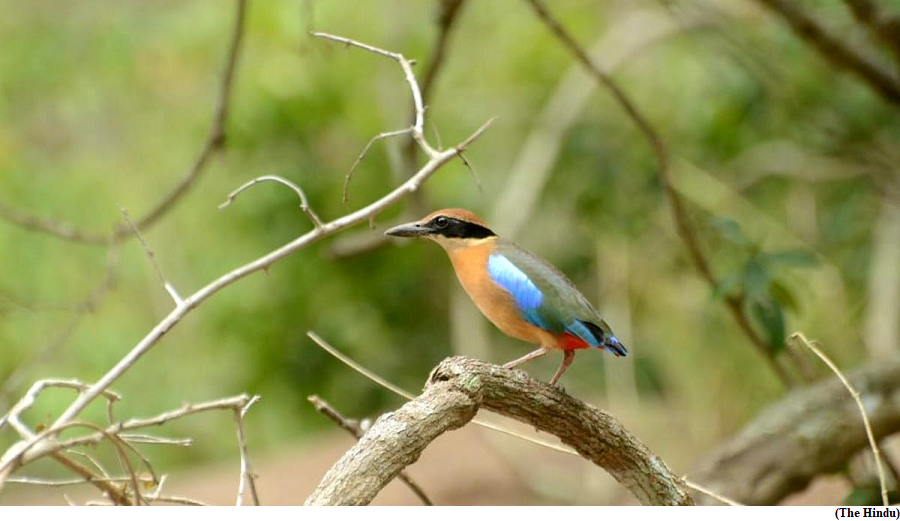Pittas find new haven in Odisha districts (GS Paper 3, Environment)

Why in news?
- In the first-ever census of mangrove pitta birds carried out in two coastal districts of Odisha, 179 such birds were sighted.
Key Highlights:
- The first census of mangrove pitta (Pitta megharencha) birds was focused on the mangrove patches all along the coasts of Kendrapara and Jagatsingpur districts.
- The census was carried out by point count method, either by walking in the forest or using country boats in the creeks.
- The highest concentration of the birds has been found in the mangroves near the Mahipura river mouth inside the Bhitarkanika National Park.
Characteristics of Mangrove pitta:
- Mangrove pitta birds are a nearly threatened species found in a few pockets of eastern India, including Bhitarkanika in Odisha and the Sundarbans in West Bengal.
- The mangrove pitta is found in coastal mangrove forests of India, foraging on the ground and resting on the trees.
ISRO to launch Singapore 750-kg satellite with PSLVC 55 mission
(GS Paper 3, Science and Technology)
Why in news?
- The Indian Space Research Organisation (ISRO) is gearing up for its next big mission to launch a customer satellite in an orbit around the planet.
- The TeLEOS-2 mission will launch onboard ISRO'S workhorse Polar Satellite Launch Vehicle (PSLV) on its 55th mission to date.

Details:
- The Singaporean probe is an Earth Observation Satellite, which has been designed to capture round-the-clock, all-weather satellite imagery.
- The 750-kilogram satellite, developed by ST Engineering, will provide imagery that could be used for hotspot monitoring and haze management, air crash search and rescue operations, and much more.
What is PSLV?
- The PSLV is a third-generation launch vehicle developed solely in India and was the first launched from India to be equipped with liquid stages.
- The rocket is capable of placing multiple payloads into orbit and has been used to launch various satellites into Geosynchronous and Geostationary orbits.
- During its last mission, PSLV deployed an Earth Observation Satellite (EOS-06) and eight nano-satellites with a lift-off mass of 321 tonnes into orbit.
- The Primary satellite (EOS-06) was separated in Orbit-1. Subsequently, orbit change was conducted using two Orbit Change Thrusters (OCTs) introduced in the Propulsion Bay Ring of the PSLV-C54 Vehicle.
- The XL variant of PSLV, which will be used during the C-55 mission, has 6 solid rocket strap-on motors to augment the thrust.
- The rocket is capable of launching 1,750 kg of payload to Sun-Synchronous Polar Orbits at 600 km altitude and 1,425 kg into Geosynchronous and Geostationary orbits.
PSLVC-53:
- This is not the first launch of a Singaporean satellite from India. The Indian space agency launched three Singaporean satellites with the PSLVC-53 mission in June 2022.
- The spacecraft carried the DS-EO satellite, NeuSAR, a 155 kg satellite, and Scoob-1 of Nanyang Technological University (NTU), Singapore.
- The DS-EO satellite carried an Electro-Optic, multi-spectral payload with 0.5 m resolution imaging capability.
- Meanwhile, the SCOOB-I was the first satellite in the Student Satellite Series (S3-I), a hands-on student training program from the Satellite Research Centre (SaRC) at Singapore's NTU School of Electrical and Electronic Engineering.
What’s next?
- The PSLV C-55 mission is scheduled to launch from the Satish Dhawan Space Center in Sriharikota on April 22.



